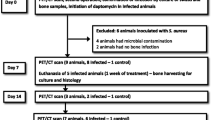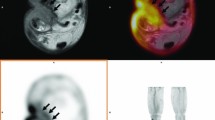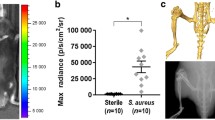Abstract
Purpose
Early diagnosis and therapeutic monitoring of acute osteomyelitis (AO) is challenging. Here, we use a polyethylene glycol (PEG)ylated chemotactic peptide cinnamoyl-F-(D)L-F-(D)L-F (cFLFLF) conjugated with hydrazinonicotinamide (HYNIC) and labeled with Tc-99m ([99mTc]cFLFLF) to image AO in a rat model and to validate its efficacy in early diagnosis and therapeutic evaluation of AO.
Procedures
Forty rats were divided into eight groups of five each. Groups A, B, C, G, and H were AO models, and D, E, and F were sham controls. Groups A and D underwent [99mTc]cFLFLF scintigraphy, groups B and E underwent [99mTc]methylene diphosphonate ([99mTc]MDP) bone scan, and groups C and F underwent 2-deoxy-2-[18F]fluoro-d-glucose ([18F]FDG) positron emission tomography (PET)/computed tomography (CT) scan. [99mTc]cFLFLF biodistribution was assessed in group G. The response to antibiotic therapy was evaluated using [99mTc]cFLFLF scintigraphy in group H. Conventional radiographs were obtained following scintigraphy. Ratios of infected or sham-operated tibia to the opposite tibia (T/B) were calculated. Immediately after the imaging studies, infected tibias were excised and underwent histopathological analysis and immunohistochemistry staining.
Results
AO was present in all rats of groups A, B, C, G, and H. Total histological scores were not significantly different among groups A, B, and C (F = 0.34, p = 0.71). The biodistribution results revealed significant uptake and excellent retention of [99mTc]cFLFLF in the infected tibia. [99mTc]cFLFLF scintigraphy and [99mTc]MDP bone scan both detected AO. The mean T/B ratio of [99mTc]cFLFLF scintigraphy 1 h postinjection was 2.09-fold higher than that of [99mTc]MDP bone scan (t = 13.81, p <0.001). The mean T/B ratio of [18F]FDG PET/CT scan was not significantly different from the control group F (t = 2.17, p = 0.062). [99mTc]cFLFLF scintigraphy revealed a significant attenuation of inflammation in group H following a 3-week antibiotic treatment, which was verified by histopathological analysis and immunohistochemistry staining.
Conclusion
Our results suggest that the specificity and image quality of [99mTc]cFLFLF are superior to those of the [99mTc]MDP and [18F]DFG imaging probes currently used for early diagnosis of AO. Furthermore, [99mTc]cFLFLF was able to effectively evaluate the therapeutic response to antibiotic treatment of AO. Our data suggest that [99mTc]cFLFLF is a promising imaging agent for detection of infectious diseases.





Similar content being viewed by others
References
Peltola H, Paakkonen M (2014) Acute osteomyelitis in children. N Engl J Med 370:352–60
Yeo A, Ramachandran M (2014) Acute haematogenous osteomyelitis in children. BMJ 348:g66
Lew DP, Waldvogel FA (2004) Osteomyelitis. Lancet 364:369–79
Gotthardt M et al (2010) Imaging of inflammation by PET, conventional scintigraphy, and other imaging techniques. J Nucl Med 51:1937–49
El-Maghraby TA, Moustafa HM, Pauwels EK (2006) Nuclear medicine methods for evaluation of skeletal infection among other diagnostic modalities. Q J Nucl Med Mol Imaging 50:167–92
Horger M et al (2007) Added value of SPECT/CT in patients suspected of having bone infection: preliminary results. Arch Orthop Trauma Surg 127:211–21
Palestro CJ (2009) Radionuclide imaging of infection: in search of the grail. J Nucl Med 50:671–3
Basu S et al (2009) Functional imaging of inflammatory diseases using nuclear medicine techniques. Semin Nucl Med 39:124–45
van der Bruggen W et al (2010) PET and SPECT in osteomyelitis and prosthetic bone and joint infections: a systematic review. Semin Nucl Med 40:3–15
Stumpe KD, Strobel K (2006) 18F FDG-PET imaging in musculoskeletal infection. Q J Nucl Med Mol Imaging 50:131–42
Locke LW et al (2009) A novel neutrophil-specific PET imaging agent: cFLFLFK-PEG-64Cu. J Nucl Med 50:790–7
van der Laken CJ et al (1997) Technetium-99m-labeled chemotactic peptides in acute infection and sterile inflammation. J Nucl Med 38:1310–5
Fukushima N et al (2005) Establishment of rat model of acute staphylococcal osteomyelitis: relationship between inoculation dose and development of osteomyelitis. Arch Orthop Trauma Surg 125:169–76
Zhang Y et al (2010) Neutrophil targeting heterobivalent SPECT imaging probe: cFLFLF-PEG-TKPPR-99mTc. Bioconjug Chem 21:1788–93
Vallabhajosula S (1997) Technetium-99m-labeled chemotactic peptides: specific for imaging infection? J Nucl Med 38:1322–6
Derian CK et al (1996) Selective inhibition of N-formylpeptide-induced neutrophil activation by carbamate-modified peptide analogues. Biochemistry 35:1265–9
Fritz JM, McDonald JR (2008) Osteomyelitis: approach to diagnosis and treatment. Phys Sportsmed 36: nihpa116823
Nguyen HA et al (2006) Factors influencing the intracellular activity of fluoroquinolones: a study using levofloxacin in a Staphylococcus aureus THP-1 monocyte model. J Antimicrob Chemother 57:883–90
Enzmann G et al (2013) The neurovascular unit as a selective barrier to polymorphonuclear granulocyte (PMN) infiltration into the brain after ischemic injury. Acta Neuropathol 125:395–412
Acknowledgments
This work was supported by the National Natural Science Foundation of China (No. 81201117).
Conflict of Interest
No other potential conflict of interest relevant to this article was reported.
Author information
Authors and Affiliations
Corresponding authors
Rights and permissions
About this article
Cite this article
Chen, J., Cheng, H., Dong, Q. et al. [99mTc]cFLFLF for Early Diagnosis and Therapeutic Evaluation in a Rat Model of Acute Osteomyelitis. Mol Imaging Biol 17, 337–344 (2015). https://doi.org/10.1007/s11307-014-0787-3
Published:
Issue Date:
DOI: https://doi.org/10.1007/s11307-014-0787-3




